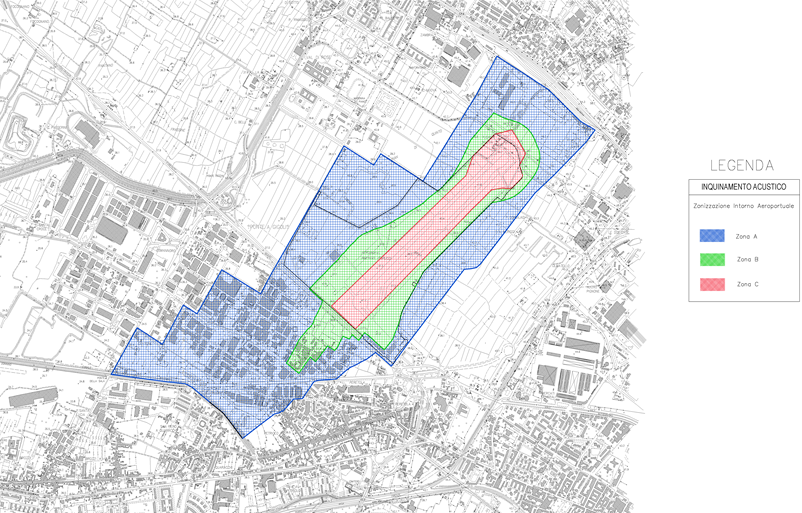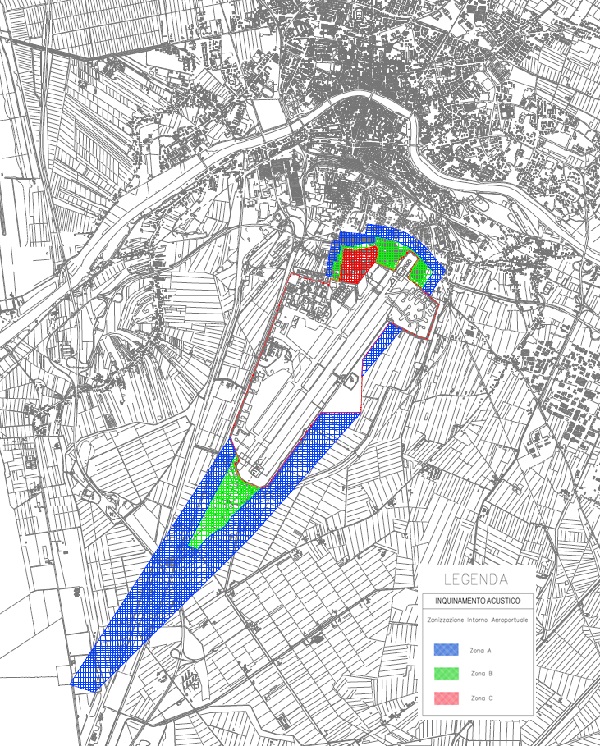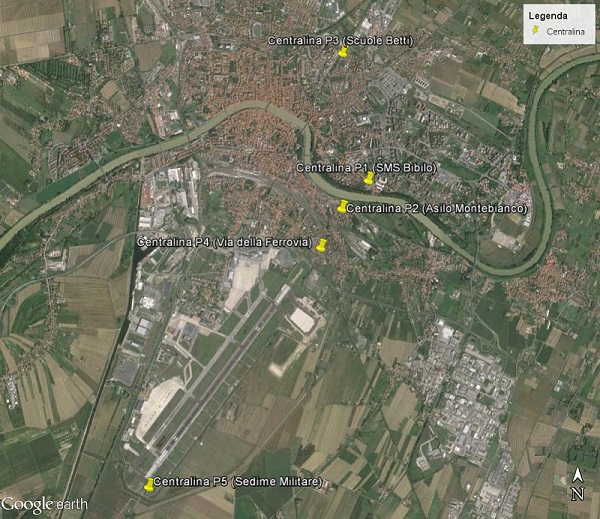Florence
The sustainability of the development of the airport and environmental protection issues are, together with the quality of services and safety, a priority for Toscana Aeroporti. In this perspective, Toscana Aeroporti controls the impact of noise levels on the territory by adopting an airport noise monitoring system compliant with the technical and structural specifications issued with DM 31/10/97 and DM 16/03/98.
The system has the purpose of monitoring the impact of noise generated by airport activities on the areas surrounding the airport.
Legislation on aviation noise pollution
EU Legislation
National Legislation
Airport noise levels
The Florence airport has adopted a system for the monitoring of its noise levels by measuring the noise produced at ground level to assess the impact of sound and mitigate its effects on the environment.
The noise level monitoring system allows for:
monitoring the sound pressure caused by flight operations on the areas surrounding the airport;
measuring and recording the noise of flight operations continuously with a network of phonometers and radar tracing instruments;
managing relationships wit the community by publishing data on noise levels.
The effects of the noise produced by flight operations can be monitored continuously by crossing the information provided by this system.
The airport noise monitoring activity is performed by TA – Florence under the supervision of local public bodies (DA ENAC, ARPAT-Area vasta Centro-Settore Agenti Fisici). In particular, ARPAT accesses the airport noise monitoring system and periodically conducts parallel measurement campaigns to check the correctness of data.
Flight path monitoring
As regards the Florence airport, ENAV provides Toscana Aeroporti with radar tracings of the flights operated by the airport, so that the Airport Operator can analyse them and detect any possible violation of the noise abatement procedure concerning takeoffs from runway # 23, i.e. Towards Quaracchi/Peretola (see AIP AD 2 LIRQ 1-10).
The Airport Commission
A special Commission, created pursuant to art. 5 of DM - Ministerial Decree - 31-Oct-1997 and chaired by ENAC, consisting of the representatives of the Ministry of the Environment - ISPRA, ENAV (the National Board for Flight Assistance), the municipalities bordering the airport, the Province, the Tuscany Regional Government, ARPAT, representatives of the air carriers and TA, operates at the Florence airport and has established the following policies over the years:
• noise abatement procedures;
• airport noise zoning;
• aircraft noise mitigation and abatement measures.
Airport noise zoning
The airport noise zoning approved by the Florence Airport Commission on 10 May 2005, which defined the airport surrounding areas and the related buffer zones (Zones A, B and C defined in the Ministerial Decree of 31 October 1997), applies to the Florence airport.
The table below shows the regulatory limits established by the above-mentioned Ministerial Decree for the LVA index.
| Zona | Limite di LVA |
| Zona A | 65 dB(A) |
| Zona B | 75 dB(A) |
| Zona C | >75 dB(A) |
| Al di fuori delle zone A, B, C | 60 dB(A) |

Fig.1 Airport Zoning
The LVA index
The noise produced by landing and departing aircraft is determined by using the method described in the applicable Italian legislation (DM 31/10/97) by using the so-called LVA indicator (Airport Noise Level Assessment). A number of devices record the noise generated by flying aircraft, which is measured by using several parameters, including the SEL (Sound Exposure Level). The logarithmic sum of all the SELs recorded by each device in a given day determined the daily LVA for that device. By measuring noise pressure, this system allows for the determination of the noise descriptor called “LVA” . The annual LVA is the logarithmic mean of the daily LVAs recorded over the three peak weeks, which are the weeks with the highest number of movements, as identified in the following three quarters of the year:
1 October - 31 January;
1 February - 31 May;
1 June - 30 September.
The phonometer network
TA-Florence constantly monitors the airport noise impact through a network of monitoring devices in compliance with the technical and structural specifications issued with DM 31/10/97 and DM 16/03/98, consisting in the following main components:
• Four fixed measurement devices located in four different points of the territory of the Municipality of Florence under takeoff and landing paths of the Florence airport and a mobile measurement device. The fixed devices are called “Gonio”, “Poste”, “Alcatel” and “Silfi”, the mobile device "Carrello".
• A central data capture and storage system, consisting of the necessary software and hardware to capture and process the data collected by the devices and by externa sources, such as the radar tracings transmitted by ENAV.
• SARA Software (airport noise system capture) required for the analysis and processing of data, correlation of phonometric data with flight data, calculation of noise descriptors, particularly LVA, for the presentation of results. SARA is capable of discriminating noise events caused by aircraft and correlating them to flying operations to eventually validate the data obtained. SARA has been tested by MATTM (Ministero dell'Ambiente e della Tutela del Territorio e del Mare - the Ministry of the Environment and for the Protection of the Territory and the Sea) and is compliant with the guidelines issued by ISPRA.
The phonometer network
TA-Florence constantly monitors the airport noise impact through a network of monitoring devices in compliance with the technical and structural specifications issued with DM 31/10/97 and DM 16/03/98, consisting in the following main components:
• Four fixed measurement devices located in four different points of the territory of the Municipality of Florence under takeoff and landing paths of the Florence airport and a mobile measurement device. The fixed devices are called “Gonio”, “Poste”, “Alcatel” and “Silfi”, the mobile device "Carrello".
• A central data capture and storage system, consisting of the necessary software and hardware to capture and process the data collected by the devices and by externa sources, such as the radar tracings transmitted by ENAV.
• SARA Software (airport noise system capture) required for the analysis and processing of data, correlation of phonometric data with flight data, calculation of noise descriptors, particularly LVA, for the presentation of results. SARA is capable of discriminating noise events caused by aircraft and correlating them to flying operations to eventually validate the data obtained. SARA has been tested by MATTM (Ministero dell'Ambiente e della Tutela del Territorio e del Mare - the Ministry of the Environment and for the Protection of the Territory and the Sea) and is compliant with the guidelines issued by ISPRA.
This is the distribution of the measuring devices around the airport:

Fig. 1. Measuring devices of the Florence airport monitoring network
The mobile device is positioned in different places from time to time around the airport based on their significance for the purpose of detecting the noise impact produced.

Fig.2. Location of the measuring devices.
The measuring device Gonio is installed in Zone B, in privately owned property
adjacent to the airport on the side of the head section of runway # 05. The measuring device is positioned on the wall of a building and the microphone is at approx. 6 metres from the ground level; the measuring device is positioned at approx. 300 metres from head section 05.
The measuring device Poste is installed in Zone A, on the flat cover of one of the buildings of the mail sorting centre adjacent to the airport on the side of the head section of runway # 23. The measuring device is located at a distance, measured as the crow flies, of approx. 1,000 metres from the head section runway # 23 and is positioned at approx. 3 metres from the walking level. The “Poste” monitoring position is also equipped with a weather station capable of continuously detecting wind and rain direction and speed, and atmospheric temperature and pressure.
The measuring device Silfi is installed in Zone A, in the private property of a busines, positioned at approx. 1,400 metres from the head section of runway # 05. The measuring device is positioned on the ground and the microphone is at approx. 6 m from the ground level. This monitoring device is also equipped with a weather station capable of continuously detecting wind and rain direction and speed, and atmospheric temperature and pressure.
The measuring device Alcatel is outside the surrounding airport area, in a private property. The measuring device is positioned on the ground and the microphone is at approx. 6 m from the ground level; the measuring device is at a distance, measured as the crow flies, of approx. 1,700 m from the head section of runway # 05.
The mobile measuring device called Carrello is provided with a telescopic microphone boom and the microphone is at approx. 3 metres from the ground. The measuring device is positioned from time to time in different places around the airport, generally in the vicinity of aircraft paths.
Pisa
The sustainability of the development of the airport and environmental protection issues are, together with the quality of services and safety, a priority for Toscana Aeroporti. In this perspective, Toscana Aeroporti controls the impact of noise levels on the territory by adopting an airport noise monitoring system compliant with the technical and structural specifications issued with DM 31/10/97 and DM 16/03/98.
The system has the purpose of monitoring the impact of noise generated by airport activities on the areas surrounding the airport.
Legislation on aviation noise pollution
EU Legislation
National Legislation
Airport noise levels
The Pisa airport has adopted a system for the monitoring of its noise levels by measuring the noise produced at ground level to assess the impact of sound and mitigate its effects on the environment.
The noise level monitoring system allows for:
- monitoring the sound pressure caused by flight operations on the areas surrounding the airport;
- measuring and recording the noise of flight operations continuously with a network of phonometers and radar tracing instruments;
- managing relationships with the community by publishing data on noise levels.
The effects of the noise produced by flight operations can be monitored continuously by crossing the information provided by this system.
The airport noise monitoring activity is performed by TA – Pisa under the supervision of local public bodies (DA ENAC, ARPAT-Area vasta Centro-Settore Agenti Fisici). In particular, ARPAT accesses the airport noise monitoring system and periodically conducts parallel measurement campaigns to check the correctness of data.
The Airport Commission
A special Commission, created pursuant to art. 5 of DM - Ministerial Decree - 31-Oct-1997 and chaired by ENAC, consisting of the representatives of the Ministry of the Environment - ISPRA, 46° Aerobrigata, the Municipality of Pisa, the Tuscany Regional Government, ARPAT and TA, operates at the Pisa airport and has established the following policies over the years:
• noise abatement procedures;
• airport noise zoning;
• aircraft noise mitigation and abatement measures.
Airport noise zoning
The airport noise zoning approved by the Pisa Airport Commission on 9 May 2012, which defined the airport surrounding areas and the related buffer zones (Zones A, B and C defined in the Ministerial Decree of 31 October 1997), applies to the Pisa airport.
The table below shows the regulatory limits established by the above-mentioned Ministerial Decree for the LVA index.
| Zona | Limite di LVA |
| Zona A | 65 dB(A) |
| Zona B | 75 dB(A) |
| Zona C | >75 dB(A) |
| Al di fuori delle zone A, B, C | 60 dB(A) |

Fig.1 Airport Zoning
The LVA index
The noise produced by landing and departing aircraft is determined by using the method described in the applicable Italian legislation (DM 31/10/97) by using the so-called LVA indicator (Airport Noise Level Assessment). A number of devices record the noise generated by flying aircraft, which is measured by using several parameters, including the SEL (Sound Exposure Level). The logarithmic sum of all the SELs recorded by each device in a given day determined the daily LVA for that device. By measuring noise pressure, this system allows for the determination of the noise descriptor called “LVA”. The annual LVA is the logarithmic mean of the daily LVAs recorded over the three peak weeks, which are the weeks with the highest number of movements, as identified in the following three quarters of the year:
1 October - 31 January;
1 February - 31 May;
1 June - 30 September.
The phonometer network of Pisa
TA-Pisa constantly monitors the airport noise impact through a network of monitoring devices in compliance with the technical and structural specifications issued with DM 31/10/97 and DM 16/03/98, consisting in the following main components:
• Four fixed measurement devices are located in four different points of the territory of the Municipality of Pisa under takeoff and landing paths; they are called P1 (Biblioteca Comunale - Municipal Library), P2 (Asilo di Via Monte Bianco - Via Monte Bianco Nursery), P3 (Asilo Via Settembrini - Via Settembrini Nursery), P4 (Via della Ferrovia), P5 (Sedime Zona Militare - Plot of land in Military Area). A fifth measurement device called “P1” is positioned at the Municipal Library of Pisa called “SMS Biblio” - at the moment this device is not working and activities are ongoing for a new positioning.
• A central data capture and storage system, consisting of the necessary software and hardware to capture and process the data collected by the devices.
• SARA Software (airport noise system capture) required for the analysis and processing of data, correlation of phonometric data with flight data, calculation of noise descriptors, particularly LVA, for the presentation of results. SARA is capable of discriminating noise events caused by aircraft and correlating them to flying operations to eventually validate the data obtained. SARA has been tested by MATTM (Ministero dell'Ambiente e della Tutela del Territorio e del Mare - the Ministry of the Environment and for the Protection of the Territory and the Sea) and is compliant with the guidelines issued by ISPRA.
This is the location of the measuring devices in the areas surrounding the airport:

Fig. 1. Measuring devices of the Pisa airport monitoring network

Fig.2. Location of the measuring devices.
Measuring device “P1” at the Biblioteca Comunale di Pisa (Municipal Library of Pisa) - “SMS Biblio”) is installed on the roof of the building. It is located at approx. 1.9 km from the head sections of the 22R and 22L runways. The microphone is installed on the roof of the building, at about 3 m from the walking level.
At the moment, this device is not operating and activities are ongoing for a new positioning.
Measuring device P2 Asilo di Via Monte Bianco, located in the courtyard of a nursery. It is located at approx. 2 km from the head section of runway # 22.
The microphone is installed on a wall of the school building, at an altitude of approx. 6 m.
Measuring device P3 Asilo di Via Settembrini positioned on the roof of a nursery. It is located at approx. 4 km from the head section of runway # 22 at about 500 m from the old city walls.
The microphone is installed on the roof of the school, at approx. 3 m from the walking level.
Measuring device P4 Via Della Ferrovia is installed in Zone A, located within a fenced area on the border of a secondary street with low traffic levels. It is located at approx. 500 m from the head section of runway # 22.
The microphone is installed on a reinforced concrete base at an altitude of approx. 6 m.
Measuring device P5 Sedime-Zona Militare is installed in Zone C, located in the airport plot in the vicinity of the perimeter, at about 200 m from head section 04.
The microphone is installed on a reinforced concrete base at an altitude of approx. 4m.
